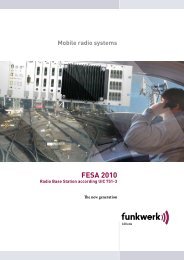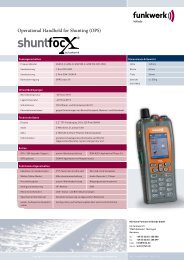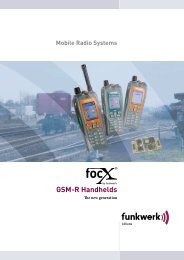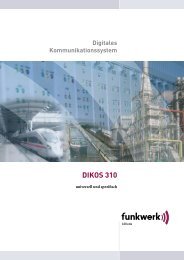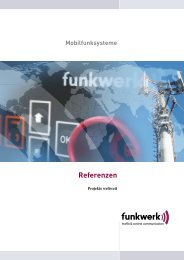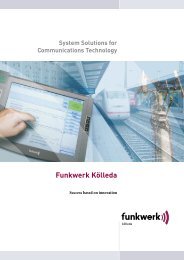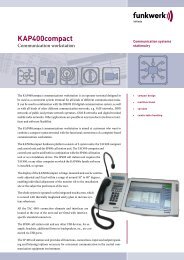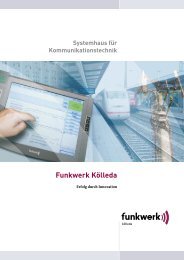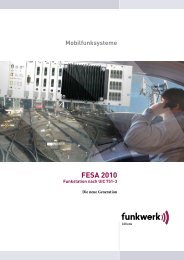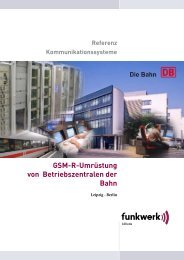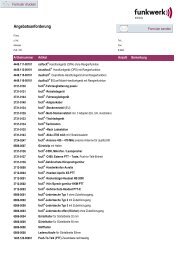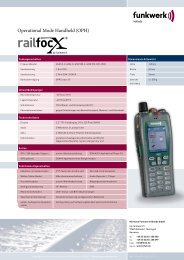DMR Digital Mobile Radio - Romkatel
DMR Digital Mobile Radio - Romkatel
DMR Digital Mobile Radio - Romkatel
You also want an ePaper? Increase the reach of your titles
YUMPU automatically turns print PDFs into web optimized ePapers that Google loves.
Technical Details<br />
<strong>DMR</strong> Features<br />
Fast call setup times and stabile high voice- and data transmission quality up to<br />
the edges of network coverage at the same ERP levels (ERP: effective radio power),<br />
as previously used within the analogue networks, are obvious improvements.<br />
Due to short switching times within the transceiver hardware the provision of a<br />
full-duplex mode for voice communication is possible by using one single radio<br />
carrier only. Higher link capacity on the air interface at a given bandwidth can<br />
be provided because of the two-timeslot TDMA-channel access scheme (TDMA:<br />
Time Division Multiple Access) at one RF-carrier. In addition, the specified <strong>DMR</strong><br />
RF-carrier spacing is 12.5 kHz only.<br />
Due to the TDMA-based discontinuous transmission, longer usage times can be<br />
achieved at the same battery capacity for handhelds.<br />
Further features include:<br />
■ Transmission of calling status (e.g. busy tone, calling tone, user ID, etc.)<br />
■ Easy integration of TCP/IP- protocol based packet data transmission<br />
(6.5 kbps per timeslot)<br />
■ Short Data Service (SDS)<br />
The Funkwerk Solution<br />
Based on the dual mode capability of Funkwerk’s solution, a useful platform<br />
will be provided for enabling longer term system migrations from the analogue<br />
to the digital era. Old terminal devices can be swapped step by step. After a<br />
complete change out of the old terminals, the mode change from analogue to<br />
<strong>DMR</strong> can be easily implemented.<br />
The modular hardware design of the terminal equipment (optional GSMmodule<br />
and/or GPS) as well as many interfaces allow for easy integration,<br />
adaptation, as well as the new development of application environments (e.g.<br />
GPS-tracking, dead-man’s-control, railway shunting operation, transponder<br />
recognition, and many other applications).<br />
<strong>DMR</strong><br />
68 - 87,5 MHz (4m)<br />
<strong>DMR</strong><br />
146 - 174 MHz (2m)<br />
TETRA (BOS)<br />
380 - 385 / 390 - 395 MHz (0,7 m)<br />
TETRA<br />
385 - 390 / 395 - 400 / 410 - 430 / 440 - 470 MHz (0,7 m)<br />
<strong>DMR</strong>-TETRA-Frequency diagram<br />
Relevant <strong>DMR</strong> specifications<br />
of ETSI<br />
■<br />
■<br />
■<br />
■<br />
■<br />
■<br />
■<br />
■<br />
TS 102 361-1<br />
TS 102 361-2<br />
TS 102 361-3<br />
TS 102 361-4<br />
TS 102 362-1<br />
TS 102 362-2<br />
TS 102 362-3<br />
TR 102 398<br />
<strong>DMR</strong><br />
406 - 430 / 440 - 470 MHz (0,7 m)<br />
400<br />
300<br />
200<br />
100<br />
3



